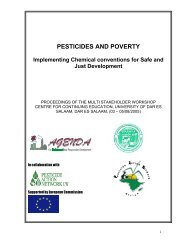Your Daily Poison - Pesticide Action Network UK
Your Daily Poison - Pesticide Action Network UK
Your Daily Poison - Pesticide Action Network UK
Create successful ePaper yourself
Turn your PDF publications into a flip-book with our unique Google optimized e-Paper software.
APPENDIX 3 The regulatory testing and<br />
assessment of pesticides<br />
According to the official guidance*<br />
pesticide legislation aims to ensure that<br />
◆ <strong>Pesticide</strong>s are only approved for use if<br />
they are effective;<br />
◆ No-one develops any serious illness<br />
through the use of pesticides;<br />
◆ No-one is harmed or made ill by the<br />
presence of pesticide residues in food<br />
or drink;<br />
◆ When pesticides are used according<br />
to the conditions of their approval,<br />
any adverse effects on wildlife or the<br />
environment are sufficiently small to<br />
be deemed acceptable.<br />
At the approval stage, regulators make a<br />
careful scientific assessment of the<br />
pesticide, based mainly on laboratory<br />
animal experiments. In 2004, 28 252<br />
procedures on 28 243 animals relating<br />
to ‘agriculture’ were carried out,<br />
involving animals**. This excludes tests<br />
done on animals for non-agricultural<br />
pesticides, biocides, and household<br />
products.<br />
Human toxicity data is used when<br />
occupational health and epidemiological<br />
studies are available, but before a<br />
substance is registered there has been<br />
very little, if any, human exposure.<br />
Regulators periodically review pesticides<br />
in use and carry out the surveillance of<br />
pesticide-related ill-health via a number<br />
of schemes, aiming to detect adverse<br />
effects which were not anticipated at the<br />
approval stage.<br />
For a pesticide to be registered, the<br />
agrochemical company has to submit to<br />
the regulators a ‘dossier’ comprising an<br />
extensive range of data, broadly falling<br />
into seven areas:<br />
1. Physico-chemical properties<br />
2. Potential toxicity in humans<br />
3. Dietary intake<br />
4. Exposure to operators, other<br />
workers and ‘bystanders’<br />
5. Environmental fate and behaviour<br />
6. Ecotoxicology<br />
7. Efficacy and risk to following crops<br />
To assess the potential toxicity in<br />
humans of the pesticide, the scientists<br />
aim to establish a ‘No Adverse Effect<br />
Level’ (NOAEL) for any ill-effects that<br />
might occur. A NOAEL is the highest<br />
dose administered to laboratory animals<br />
in an investigation that does not cause<br />
them ‘observable’ ill-effects. Nonobservable<br />
effects, such as subtle<br />
changes in neurological function, pain,<br />
dizziness, numbness and psychological<br />
symptoms, are not included in this<br />
value.<br />
The data that are required to assess<br />
potential human toxicity cover:<br />
◆ How the active ingredient is<br />
metabolised and excreted in<br />
mammals.<br />
◆ The ‘acute’ toxicity of a single high<br />
dose of the active ingredient and of<br />
the product by oral, dermal and<br />
inhalation exposure, usually in rats.<br />
◆ The ‘sub-acute’ and ‘chronic’ toxicity<br />
of the active ingredient when<br />
administered to animals over periods<br />
of several weeks or longer (in two<br />
species, typically rats for up to two<br />
years and dogs for up to a year).<br />
◆ The potential of the active ingredient<br />
to cause cancer when it is<br />
administered over a lifetime (in two<br />
species, usually in rats for a<br />
minimum of two years and in mice<br />
for 18 months).<br />
◆ The genotoxicity of the active<br />
ingredient, ie its potential to damage<br />
the genetic material in cells,<br />
potentially causing cancer.<br />
Genotoxicity is (exceptionally) treated<br />
as a hazard trigger. Genotoxic<br />
pesticides are now not registered.<br />
◆ The developmental toxicity of the<br />
active ingredient, ie whether it can<br />
cause birth defects when<br />
administered to female animals<br />
during pregnancy.<br />
◆ The toxicity of the active ingredient<br />
when it is administered to at least<br />
two successive generations of animals<br />
over the course of their lifetime. This<br />
provides further information on the<br />
chronic toxicity of the pesticide and<br />
aims to detect its potential to impair<br />
fertility and the ability to rear young.<br />
◆ The potential of the active ingredient<br />
and product to irritate the skin or eyes.<br />
◆ The potential of the active ingredient<br />
and product to cause skin allergies<br />
(sensitisation).<br />
the second <strong>UK</strong> pesticide exposure report 21

















